Commemorating another ‘Sabre Slayer’ – then Flying Officer P S Pingale, who had to eject after being shot down on September 6th, took to the air ten days later and extracted his pound of flesh – by shooting down a PAF Sabre. During this short but fierce encounter, Pingale also went head to head in air combat with the Pakistani ace M M Alam.
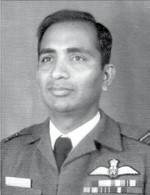 Commemorating another ‘Sabre Slayer’ – then Flying Officer P S Pingale, who had to eject after being shot down on September 6th, took to the air ten days later and extracted his pound of flesh – by shooting down a PAF Sabre. During this short but fierce encounter, Pingale also went head to head in air combat with the Pakistani ace M M Alam. This account is excerpted from the book – The India-Pakistan Air War of 1965 by P V S Jagan Mohan and Samir Chopra (Manohar Publishers 1965)
Commemorating another ‘Sabre Slayer’ – then Flying Officer P S Pingale, who had to eject after being shot down on September 6th, took to the air ten days later and extracted his pound of flesh – by shooting down a PAF Sabre. During this short but fierce encounter, Pingale also went head to head in air combat with the Pakistani ace M M Alam. This account is excerpted from the book – The India-Pakistan Air War of 1965 by P V S Jagan Mohan and Samir Chopra (Manohar Publishers 1965)
On September 16th, No.7 Squadron went into action against the Sabres on the Amritsar front. Hunters from Halwara had not seen air combat since the evening of September 6th but that was soon to change.
Late in the afternoon at Halwara, Fg Offr Prakash Sadhashivrao ‘Pingo’ Pingale of 7 Squadron was on ORP duty along with Fg Offr Farokh Dara ‘Bunny’ Bunsha. Pingale had returned from a medical checkup in Delhi a couple of days earlier – necessitated by his ejection over Halwara on September 6th. He had since flown a couple of interdiction strikes across the border. Bunsha, originally from 20 Squadron, had been deputed to 7 Squadron for the war. Suddenly the scramble order was given and both pilots took off in their Hunters. Once airborne, the fighter controller Fg Offr RC Mahadik gave Pingale an initial vector in a northwesterly direction towards Jullundhur. They were flying at 20,000 feet altitude at high speed – nearly 0.9 Mach – with eyes preened to spot intruding aircraft.
The intruders were two Sabres led by Sqn Ldr MM Alam with Fg Offr MI Shaukat – a young pilot with 80 hours on the Sabre – as his wingman. The Sabres were on a baiting mission and were warned about the approaching Hunters by PAF GCI at Sakesar. Alam was looking to enhance his score; an eager Shaukat was set to support him.
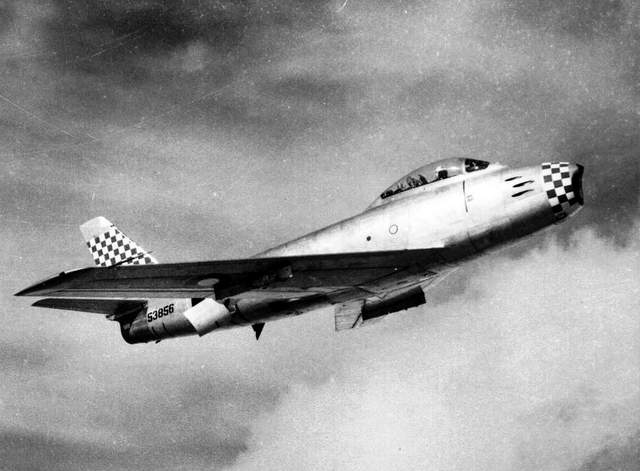
A Pakistani F-86 Sabre jet. The fighter aircraft carried six 0.50 inch calibre machine guns in the nose – three of the gun ports being clearly visible just behind the checkerboard markings on the nose.
The Indian pilots were flying the ‘loose deuce’ or ‘fighting’ formation, with Pingo leading the formation and Bunsha following to his left about 200 yards to the rear. The ‘loose deuce’ was a well-established battle formation for air combat – the US Navy would put it to particularly effective use over the skies of North Vietnam. It was easy to maintain and track: Bunsha could not only cover Pingale’s rear but also watch out for any threats from his rear.
Combat!
Pingale spotted a single aircraft going in the opposite direction at a lower altitude. The aircraft looked like a Mystere. As it flew on almost directly beneath them, Pingale recognized the green and white PAF roundels on the aircraft. It was Alam’s Sabre. Pingale called Bunsha on the R/T to announce an attack. Both Hunters peeled off and turned around in a dive. With the Hunters in a turn, the Sabre leisurely put in a turn from its southeastern direction to south. As both the Hunter pilots approached the Sabre from the rear, the Sabre was still flying straight, maintaining constant altitude and speed and not doing any evasive maneuvering. A puzzled Pingale rapidly closed in with his Hunter.
As he did so, he instinctively looked to his right and saw at approximately 4 o’clock another Sabre – flown by Shaukat Ali – at 800 yards and rapidly closing in, ready to fire. Pingale decided to take on the Sabre coming in behind, as it would be easier for him to engage rather than Bunsha who was much closer to it. Bunsha was in a better position to continue the attack on the Sabre ahead. Pingale called out on the R/T to Bunsha “Bunny, go after the bogey ahead; I’ll tackle this bogey coming from the rear”. Bunsha replied ‘Roger’ and went after Alam’s Sabre.
As Pingale put in a steep turn to fly head on to Ali’s Sabre, both passed each other at a distance. Pingale reversed into another turn and before Ali could try and turn Pingo was behind him. Shaukat frantically pulled up the Sabre into the sun, hoping that he would lose the Hunter due to the glare, but Pingo was ready:
“We had practiced this many times earlier. You can’t go forever into the sun because you don’t have the energy. The speed will decay and you will fall off, so I had to just wait and keep looking at the sun, hoping to see him when he comes out of somewhere, either to the left or to the right of the sun.”
Sure enough, as its speed bled off the Sabre fell. Pingo saw the Sabre coming out of the sun from the right and immediately increased power. Even as the Hunter’s powerful Rolls Royce engines kicked in, the Sabre continued to fall; Ali jettisoned his drop tanks and snapped the aircraft into a slow turn, expecting Pingale to overshoot. Pingo could see the Sabre’s leading edge slats open and knew the aircraft was going to turn tightly. As the Sabre’s speed bled off, Ali probably panicked in anticipation of stalling. He once again straightened out and pulled up: a common mistake in aircombat made by pilots not comfortable with pushing their aircraft to its limits. It was a crucial error for it allowed Pingale to stay behind the Sabre.
Pingale’s first burst at the Sabre had been a wildly aimed shot: the pipper was not properly placed on the Sabre and there was no damage to the aircraft. But now, Pingale had closed in to around 250-300 yards – his training took over as he prepared for the second burst and set the correct parameters for the radar ranging gunsight. He maneuvered the Hunter to get the pipper positioned just ahead and above the Sabre’s cockpit. A single burst from his Aden gunpack would have placed a deadly salvo of 30 mm cannon shells right into the cockpit, but Pingo hesitated, thinking, “Saala mar jayega- rahne do” (the poor bugger’s going to die – let him be) . He eased back on his joystick so that the pipper moved from the Sabre’s cockpit to the center of the fuselage and pressed the gun button at 300 yards.
It was a short burst. No more than a quarter second long – but it was enough. The Sabre exploded in a massive ball of flame. The exploding debris was so close to the Hunter that Pingale would have flown through it but for the fact that Pingale was already putting his Hunter in a turn – heading for Alam.
In the meantime, Bunsha was chasing Alam who started jockeying his Sabre in turns. Pingale – who was chasing Ali – had kept an eye on Bunsha and his target. Seeing the Sabre start to maneuver, he called out a warning to Bunsha, which was acknowledged. The chase transformed into a horizontal scissors fight with both the Sabre and Hunter cutting speed and turning inside into each other in an effort to get behind each other. This was a particularly dangerous maneuver with which to fight a Sabre whilst one was flying a Hunter – especially if not supplemented by vertical breakouts by the Hunter. Pingale once again called out, “Bunny be careful, you’re losing your advantage, he’s getting behind you’. Bunsha again acknowledged.
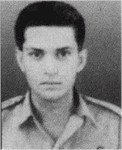 |
Fg Offr Feroze Bunsha was shot down in aircombat and lost his life on 16th September |
| Fg Offr Shaukat Ali of the PAF was shot down and taken POW – He would later join the Bangladesh Air Force after the 1971 war and then visit India again as a guest for a Staff Course! | 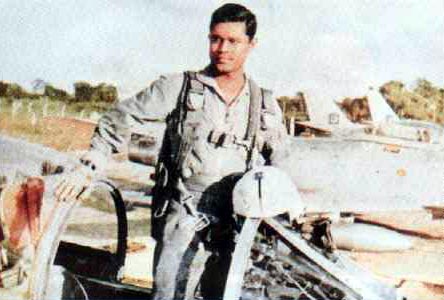 |
But the fight was uneven. Man-to-man – Alam had more experience on the Sabre with nearly 1300 hours flying it. He knew the Sabre’s quirks inside out; Bunsha one of the junior most pilots of No.20 Squadron, had less than two years of service and about 250 hours on the Hunter. Alam cut inside Bunsha’s turn and was able to take a good shot at the Hunter. As Pingale was about to deliver the coup-de-grace to Ali, he noticed Bunsha’s predicament. After firing at Ali, Pingale instantly put his Hunter in a turn towards Alam.
But it was too late. Pingo noticed Bunsha’s Hunter in a very gentle turn; it seemed to have been damaged by gunfire, and Bunsha did not appear to be engaging in combat any longer. Alam, on Bunsha’s tail, continued firing. As he closed in, Alam gave up firing at Bunsha’s Hunter and turned his aircraft straight towards Pingale. Probably Alam was responding to a call of help from Ali.
Head to Head
As both the Hunter and Sabre closed in rapidly head on, Pingale noticed the gunports of the Sabre twinkling with fire – Alam had opened fire head-on in a feeble attempt to hit him. Pingale held his fire – it was poor judgment to open fire in a head-on course, the chances of hitting your adversary were slim and besides, Pingo wanted to conserve his ammunition. The lessons from a course in armament training at ATW, Jamnagar – completed a month ago – were still fresh in his mind.
The Hunter and the Sabre crossed over at high speed. Pingale immediately reversed course, hauling the Hunter almost on its wingtip, half expecting to find the Sabre doing the same and coming back to him. But he was in for a surprise: after turning back, he could see the Sabre flying away at a high speed away from the fight. Obviously Alam had given up on the fight and was heading for home. An indignant Pingale recollects his feelings at the moment:
“My impression was that this Alam fellow tried to get out of the fight. You know when you are young and you are in a fight and all gung ho, you want the other fellow to put up a fight, you don’t want him to run away from you at the slightest hint of trouble. That is where the mettle of a fighter pilot comes in. It is like playing chicken, you are going head to head on with some fellow on a road, which is narrow. You will wait for the other guy to give way first. It all depends on to who hangs onto longer, but surely when you cross each other, then you expect both to turn around and face each other again. I found out that when I turned around, this fellow (Alam) just had not turned around and lot of distance was put in between us. So he ran away from the fight. I still recollect my thoughts at that moment, ‘This is not right; look at this fellow he’s gone away!”
Pingale started chasing the Sabre. Alam then put the Sabre into a near vertical dive to get out of range of the Hunter. The maneuver worked. Pingale put the Hunter on the Sabre’s tail, but almost blacked out trying to pull out of the dive. The Hunter clocked almost 9 to 10 G during the pullout. Pingale was already suffering from pain from the back injury sustained by the ejection over Halwara on September 6th. As he eased the pullout, he got his vision back. But there was no sign of the Sabre. Alam had made good his escape. The fighter controller also lost contact with the Sabre at low level.
Pingale flew back to base – satisfied at shooting down Ali – but sad at losing his wingman. He had not seen Bunsha after the last gentle turn he was putting in. He hoped that Bunsha had ejected and was safe, but it was not to be. Bunsha’s Hunter was later found, completely wrecked. Bunsha had not ejected. Surprisingly, even though Pingale saw his target explode in front of him, Ali had ejected in time near Tarn Tarn, unaware that a fellow pilot’s benevolence had saved his life. As he was descending in his parachute he came under fire from troops and villagers on the ground . Ali suffered a .303 bullet wound and some shotgun pellet injuries. Shaukat was handed over to the troops of the 4th Division and moved to a field hospital, where an Indian Army surgeon removed the bullets and pellets from his body. Shaukat spent the rest of the war in an Indian POW camp. It had been a classic air-battle. The inexperience of the Indian and Pakistani wingmen had been their undoing: both had failed to exploit the particular strength of their aircraft.
Pingo’s second adversary, Alam, flew back to base after which an unrelated version of the aircombat emerged from the Pakistani side: Alam claimed that Shaukat and himself were bounced by two Hunters attacking in a yo-yo maneuver, following which Alam not only shot down one Hunter with guns, but the second Hunter as well with a Sidewinder after an intense dogfight in which the Hunter tried to ‘run away from the fight’. Alam received credit for ‘downing’ two Hunters in this fight, taking his total tally to ‘nine kills’.
Pingale doesn’t agree with Alam’s description of the fight:
No missiles were fired — first he opened up with guns and when we crossed over and I turned, he was already flying straight and away trying to get out of the fight.
Back at the base, Pingale’s gun camera footage came out perfectly. He had used just half a second worth of ammunition in both his bursts. The first burst was a quarter second long. The subsequent burst, which was more devastating, was another half a second. Pingale received the Vir Chakra for downing Shaukat Ali’s Sabre. It was poetic justice for Pingale. After his early exit from combat with Rafique’s Sabre over Halwara on September 6th, he had extracted his pound of flesh from the PAF.
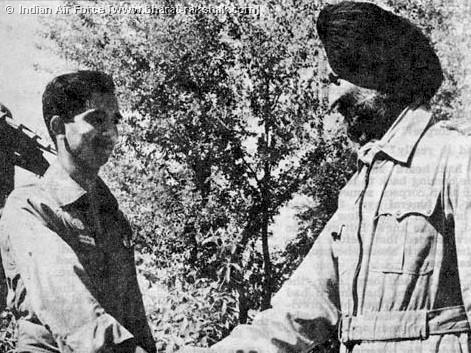 |
| Air Marshal Arjan Singh greets then Fg Offr P S Pingale after the war on a visit to Halwara. |

Excerpted from The India-Pakistan Air War of 1965 by P V S Jagan Mohan and Samir Chopra, (Manohar Publishers, 2005). Reproduction in whole or in part in any form or medium without express written permission of the Authors is prohibited.